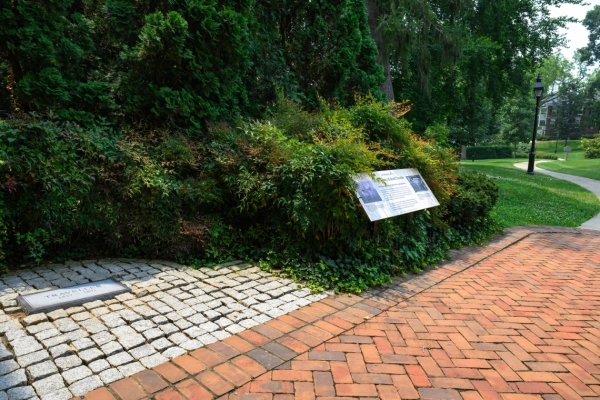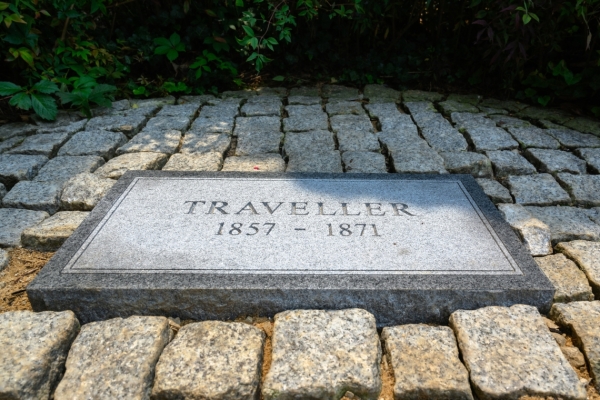Statement Regarding the Relocation of Plaques to a New Exhibit in University Chapel
Washington and Lee University has received a number of questions about the decision to relocate four historical plaques from various common spaces and academic settings on campus to our new museum spaces in the University Chapel. Many of these questions are sincere and arise from honest confusion within our community while others are based on significant misinformation. The following is intended to provide facts and context around this decision.
Key Takeaways:
- Four historical plaques relocated on campus this week are being installed along with other historically significant plaques in a new exhibit, located in University Chapel, titled “The Power of Memory: Remembering Robert E. Lee.”
- The four plaques relocated include one from Payne Hall indicating where Lee took his oath of office as president of Washington College, another from Payne Hall identifying the room that served as Lee’s office from 1865-1868, and two dedicated by the United Daughters of the Confederacy to commemorate Lee’s horse Traveller located on the side of the Lee House garage and at Traveller’s gravesite outside the chapel.
- As the Board of Trustees emphasized in its messages to the University community in June 2021 and September 2022, W&L is an educational institution and, as such, its campus is not a museum or an appropriate repository for Confederate artifacts. In keeping with this principle, over a year ago, the Board determined that these plaques should be relocated to educational exhibitions.
- Traveller’s remains, at the location next to University Chapel, are untouched and a new marker to memorialize him has been installed at the same location. The other related plaques and interpretive signage at the site will also be updated.
- The Traveller marker relocated from the Lee House garage will be replaced with a new marker at the same location in the near future that is consistent with other markers across our campus.
Over the past several years, Washington and Lee’s Board of Trustees has engaged in a careful review of the University’s symbols, names, and practices with the understanding that these communicate the University’s values and are an important component of its reputation. This work has involved extensive outreach to students, faculty, staff, alumni and parents as well as independent historians. As outlined in the Board’s June 2021 and September 2022 messages to the University community, the Board’s work has been guided by four key, overarching objectives:
- recognizing George Washington and Robert E. Lee for their important contributions to the institution;
- helping all students, faculty, and staff feel welcome, included, and able to thrive on our campus;
- reaffirming the University’s rejection of Confederate ideology; and
- presenting the University’s entire history fully and honestly.
The Board’s work has resulted in an approach to campus symbols that attempts to balance the University’s rich and complicated history with its educational mission. Washington and Lee University is an educational institution. Its campus is neither a museum nor an appropriate repository for Confederate artifacts, and as such, the Board determined that a number of plaques on campus should be relocated to a museum to be appropriately interpreted. These include certain historic plaques located in current academic, residence and gathering spaces and others placed by third parties such as The United Daughters of the Confederacy or honoring Robert E. Lee’s service as the commander of the Confederate forces.
The relocation of plaques to a new permanent exhibit titled “The Power of Memory: Remembering Robert E. Lee” currently being installed in University Chapel is part of a carefully considered series of steps to create educational exhibits and place Confederate artifacts in those exhibits and in context.
In preparation for this exhibit, two plaques – one indicating where Lee took his oath of office for the presidency of Washington College and a second identifying the room that served as his office from 1865-1868 – were moved from Payne Hall to be included in the new exhibit.
Two other plaques that were dedicated by the United Daughters of the Confederacy to commemorate Lee’s horse Traveller – one from the side of the Lee House garage that was formerly a stable, and the other at Traveller’s gravesite outside the chapel – were also relocated to be installed in the exhibit. Traveller’s remains were untouched and a new marker to memorialize him was installed at the same location. The other related plaques and interpretive signage at the site will also be updated. A new replacement marker designating Traveller’s last home in the stable at Lee House is forthcoming.
These actions are important steps in recognizing, preserving, and telling Washington and Lee’s extensive history as one of the oldest institutions of higher learning in the United States. The next and most significant step is construction of the Museum of Institutional History that will feature fixed and rotating museum exhibits, rotating gallery spaces, storage, classrooms, and an auditorium for events.
A working group comprised of trustees, administrators, faculty and alumni was formed last fall and, with the assistance of a renowned national architectural firm and museum consultant, has begun to develop a plan and process for the construction of the museum. The Museum of Institutional History, along with other museums on campus, will be dedicated to telling Washington and Lee’s 275 years of history, including the significant contributions both Washington and Lee made to our University. We expect to provide further details about this exciting project, as well as other new exhibits, in the coming months.
 A new marker was installed at Traveller’s gravesite (center).
A new marker was installed at Traveller’s gravesite (center). New marker at Traveller’s gravesite
New marker at Traveller’s gravesite
You must be logged in to post a comment.